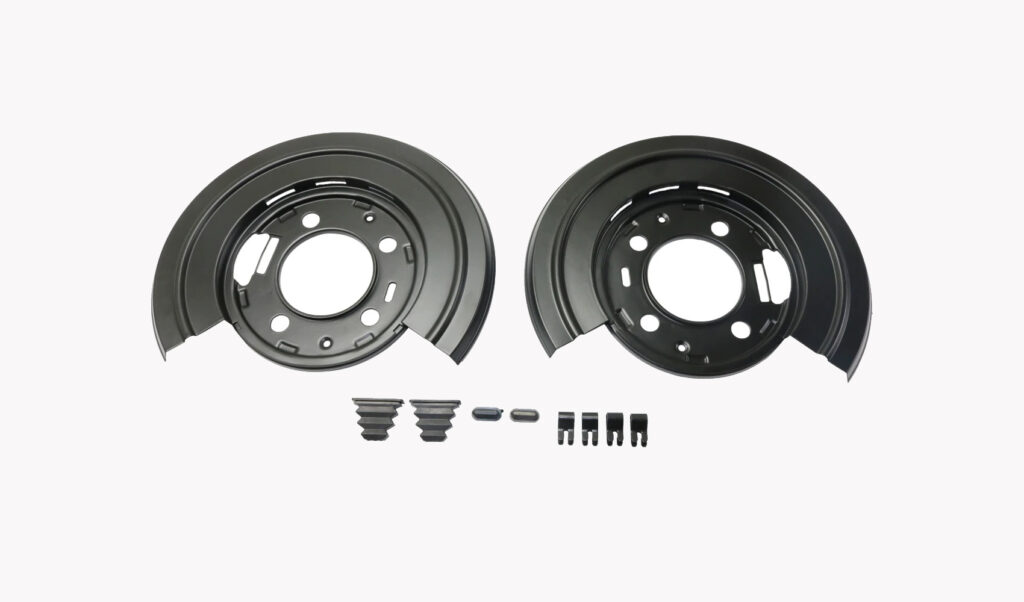What Is a Brake Dust Shield?
Also known as a wheel dust shield, the brake dust shield’s main function is to keep debris and other harmful dust out of your wheels and braking system. Additionally, it helps protect other drivetrain and suspension parts from the damaging effects of heat.
Brake dust shields are usually made of stamped steel sheet metal, but are sometimes aluminum.


What Is Brake Dust and Where Does It Come From?
Brake dust is made up of iron particles, carbon residue, and friction material. It is the byproduct of normal friction material wear while braking. Drum brakes tend to trap the brake dust created by the shoes as they wear and can cause squeaking or squealing noises until the dust is cleaned out, though this doesn’t always happen.
Disc brakes don’t store brake dust the way drum brakes do. On disc brakes, the dust tends to blow away or cling to the wheel so that it needs to be washed off for aesthetic purposes. The disc brake backing plate does nothing to prevent dust. It’s more for keeping rocks and dirt away from the rotor as the vehicle is driven.
Note: Brake dust is extremely poisonous, bad for your lungs, and should never be blown off the brake assembly with compressed air. Before doing any work on dusty brakes, always use liquid cleaners (soap and water is preferred) to remove brake dust, particularly from drum brakes after removing the brake drum.
Harmful Effects of Brake Dust
Increased Brake Noise
It’s normal for your brakes to produce brake dust, and it’s perfectly okay to see some residue on your wheels.
You may notice unusual vibration and noise once the dust gets stuck on your calipers and rotors. That’s because the accumulated dust can make the surface of your calipers and rotors uneven. A bent or damaged dust shield can also produce a brake dust shield noise that sounds like metal scraping.

Damaged Alloy Wheels
Brake dust contains abrasive substances. And dust stains in your wheels can be hard to remove. Good thing brake dust shields can help reduce the amount of dust that accumulates on your wheels.
If you notice too much brake dust in your alloy wheels, don’t hesitate to have it cleared by a professional. Leaving the stain for long periods can cause corrosion damage.
Is It Safe to Drive Without a Brake Dust Shield?
It’s technically possible to drive without brake dust shields. However, it’s recommended to have them installed if you often drive through rough terrain and areas that use a lot of mud, gravel, and/or road salt.
If you continuously drive without brake dust shields, dust particles can significantly damage your braking system.
How Much Does a Brake Dust Shield Replacement Cost?
Expect to spend anywhere between $50 and $300 for a brake dust shield replacement. Your vehicle’s year, make, and model can affect pricing.
Where to Find Top-Notch Brake Dust Shields For Your Ride
Your ride deserves the best. So if you would like to give your vehicle the best brake dust shield replacements, get them here at CarParts.com.
Use our convenient vehicle selector tool to navigate our website with ease. Input your vehicle details, and let our system filter your options to compatible brake dust shields for your ride.
All our products come with a low-price guarantee. However, this doesn’t mean that you need to compromise quality to stay within your budget. We source our replacement parts from trusted brands to ensure optimal fit and performance.
Here at CarParts.com, customer satisfaction is paramount. If you have questions about fitment or shipping, don’t think twice about calling our toll-free hotline. We’re here to assist you 24/7.
Order today, and get back on the road in no time!
Replacing Your Brake Dust Shields
Your ride’s brake dust shields are located behind the rotors, meaning, the rotors must be removed to replace them. Likewise components must be removed to replace brake shoe backing plates. Different vehicles require different procedures.

If you’re not an experienced automotive DIYer, we suggest taking your ride to an auto repair shop. A trained professional will know how to properly install your dust shields.
Tips to Reduce Brake Dust
Aside from installing brake dust shields, there are other ways to minimize brake dust. Here are some of them:
Switch to Ceramic Pads
Compared to organic brake pads, ceramic brake pads produce less dust and other particles as they get older. They’re generally more expensive than metallic pads, but the benefits are worth it. Note, however, that ceramic pads are actually only about 5% ceramic and may still make some dust.
But ceramic-based friction materials produce less sticky dust that doesn’t form a heavy coating on alloy wheels. As a result, the wheels stay cleaner for longer periods. In most cases, dust residue is still visible, but it is more difficult to see because they’re typically a lighter color.
Brake Dust Repellent
There are aftermarket brake dust repellents available on the market that can effectively repel brake dusts for a few weeks. This aerosol repellent forms a protective barrier, so that the dust doesn’t accumulate on your rims.
Applying Ceramic Coating On Your Wheels
If you have extra money to spruce up your wheels, applying a layer of wheel coating can significantly reduce the harmful effects of brake dust. These wheel coatings are typically permanent or semi-permanent, making them easier to clean.
Aside from following your routine maintenance checks, it’s also crucial to have your braking system checked if you notice something unusual like excessive brake dust or reduced braking performance. It’s better to address the issue right away, than having to spend more money on complex repairs in the future.
Any information provided on this Website is for informational purposes only and is not intended to replace consultation with a professional mechanic. The accuracy and timeliness of the information may change from the time of publication.






























